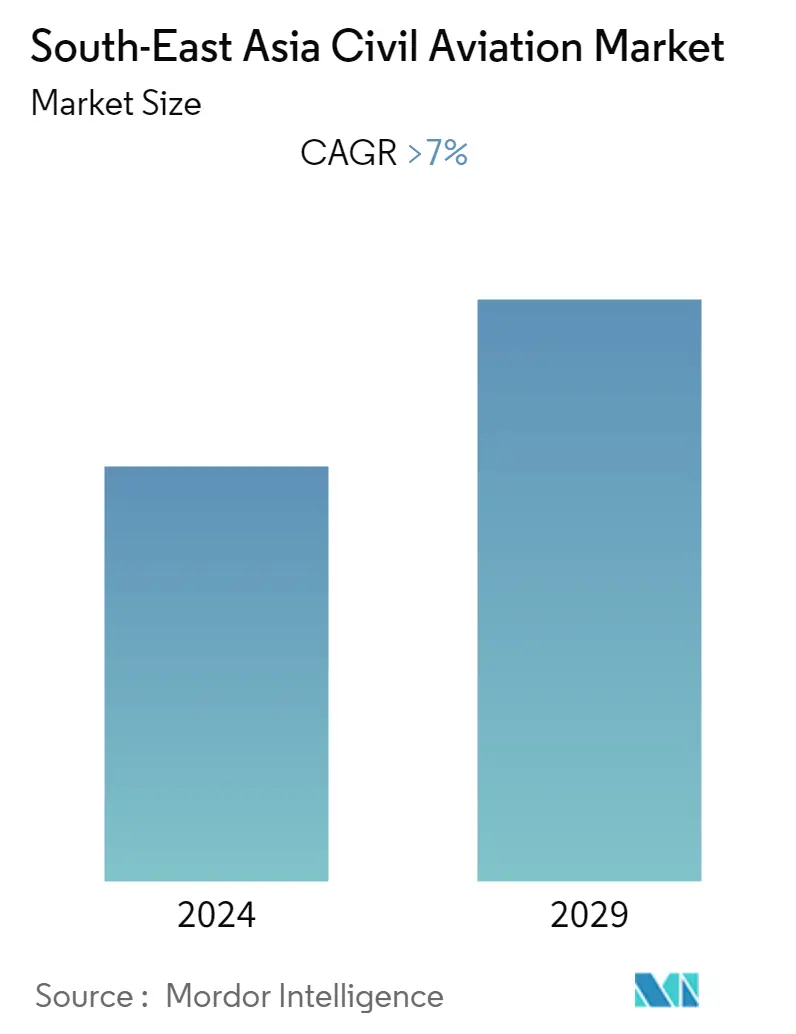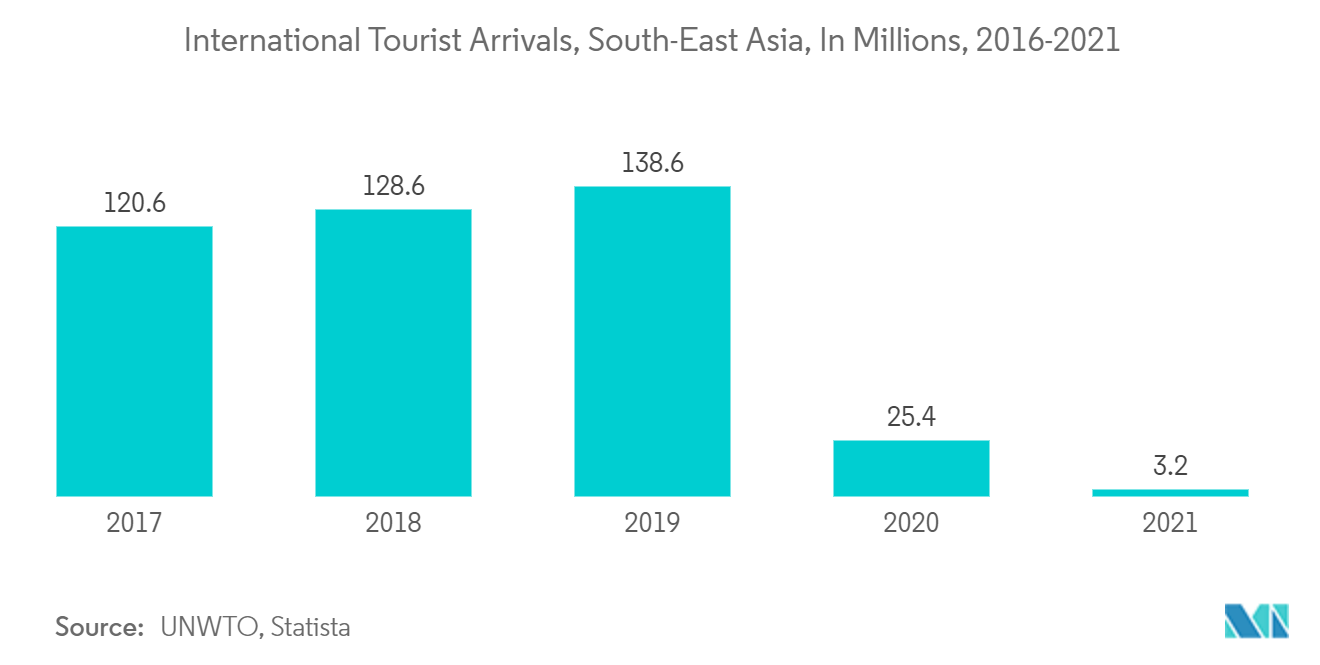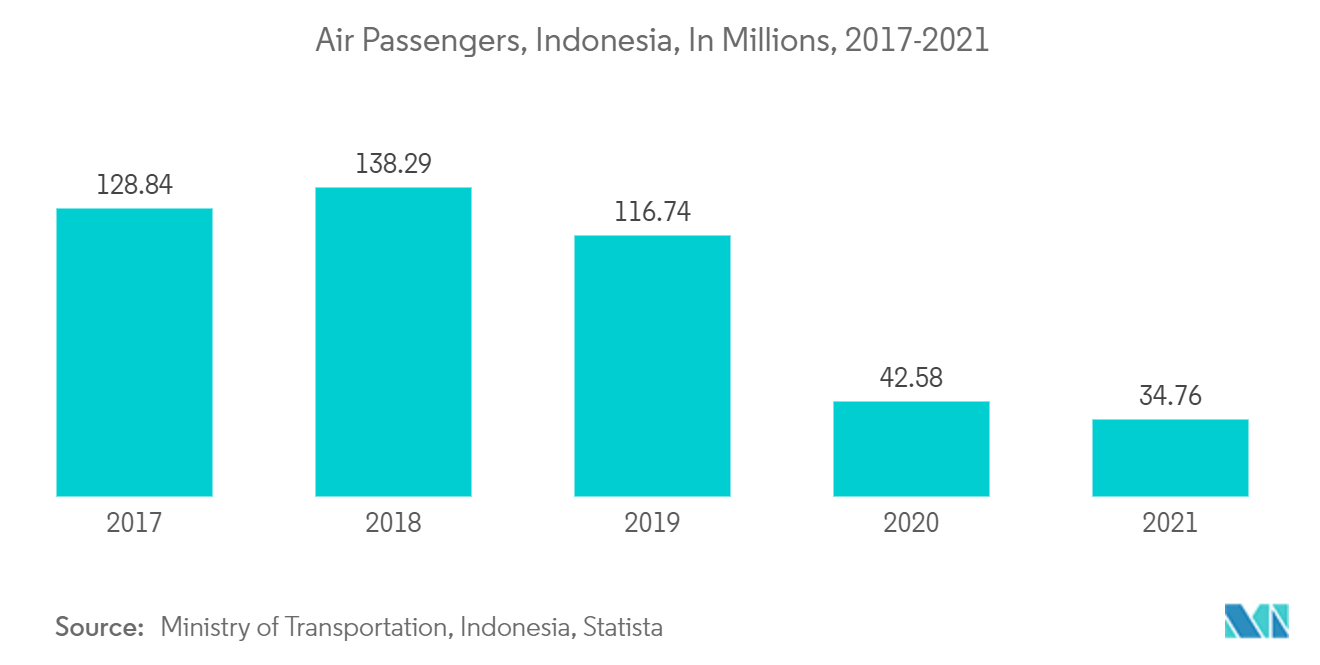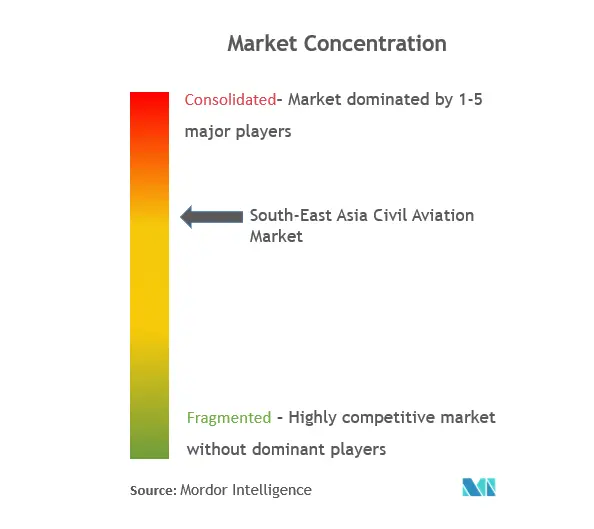South-East Asia Civil Aviation Market Size

| Study Period | 2020 - 2029 |
| Base Year For Estimation | 2023 |
| Forecast Data Period | 2024 - 2029 |
| Historical Data Period | 2020 - 2022 |
| CAGR | 7.00 % |
| Market Concentration | High |
Major Players
*Disclaimer: Major Players sorted in no particular order |
South-East Asia Civil Aviation Market Analysis
The South-East Asia civil aviation market is expected to register a CAGR of over 7% during the forecast period.
- The COVID-19 pandemic presented unprecedented challenges for the aviation sector, including in South-East Asian countries. The region has experienced a significant decline in the number of travelers, reduced demand for aircraft, and supply chain disruptions. For instance, in Indonesia, the Ministry of Transportation reported a decline in the number of airplane passengers from 117 million in 2019 to 43 million in 2020. This trend continued into 2021, with only 35 million air passengers.
- However, the aviation sector has shown signs of recovery as governments ease travel restrictions. According to the Ministry of Indonesia, the number of air travelers in 2022 reached 78 million, indicating a positive outlook for the industry.
- Several factors, including an increase in air passengers, rising tourism expenditure, and growing demand for commercial aircraft fuel the market growth in the region. Additionally, the growth in air freight transport and demand for business jets from individuals are driving the market growth.
- Despite the pandemic, Vietnam's air cargo industry experienced strong growth, with a 17% increase in air cargo traffic in 2022, reaching 1.52 million tons. This growth can be attributed to the increasing tourism and spending in the aviation sector from Southeast Asian countries.
- In summary, the aviation sector in South-East Asian countries has faced significant challenges due to the COVID-19 pandemic, but the industry is showing signs of recovery. Factors such as increasing air passengers, rising tourism expenditure, and growing demand for aircraft and business jets are driving market growth in the region.
South-East Asia Civil Aviation Market Trends
The Commercial Segment Will Showcase Highest Growth During the Forecast Period
- The commercial aircraft segment in Southeast Asia is poised for remarkable growth in the coming years. This can be attributed to several factors, such as the increasing air traffic, growing tourism, and rising expenditure on the aviation sector across the region. In 2021, the travel and tourism industry alone contributed over USD 143 billion to the Southeast Asian GDP. The easing of travel restrictions post-COVID has also led to a surge in international flight bookings to countries like the Philippines and Thailand.
- According to Travelport's booking data, in 2022, the Philippines and Thailand together represented over 50% of all international flight bookings to the region. In February 2022, international flight bookings rose by 114%, while daily flight bookings reached a staggering 294% in the Philippines. This trend is expected to continue in the coming years, leading to a further increase in air traffic.
- Moreover, the construction of new airports and the rising demand for new passenger aircraft will also fuel market growth. The Airport of Thailand (AOT) has planned major expansion projects at the Suvarnabhumi and Don Mueang International Airports in 2023, owing to a surge in passenger traffic. Boeing, an aircraft manufacturer, has projected that Southeast Asia will require 4,500 new airplanes worth USD 785 billion in the next 20 years. Therefore, the growing demand for passenger aircraft will continue to drive market growth in the region.
- In conclusion, the commercial aircraft segment in Southeast Asia is expected to witness remarkable growth in the coming years, owing to the increasing air traffic, growing tourism, and rising expenditure on the aviation sector. The construction of new airports and the demand for new passenger aircraft will further boost the market growth in the region.

Indonesia is Estimated to Show Remarkable Growth During the Forecast Period
- Indonesia continues to dominate the aviation market, holding the largest market share during the forecast period. This growth can be attributed to several factors, including a high number of airports, increased spending on the aviation sector, and a surge in tourism throughout the country. The International Air Transport Association (IATA) predicts that Indonesia, with its 251 airports, will become the world's fourth-largest aviation market by 2036. Furthermore, Indonesia is currently the second-fastest-growing aviation market globally, after China, due to its expanding aircraft procurement and trade value.
- In December 2021, PT BIDU Panji Sakti signed a memorandum of understanding (MoU) with China Construction First Group Ltd (CCFG) for the construction of a new airport in Bali. The new airport is expected to be operational by 2024, further fueling the growth of the aviation market in Indonesia.
- The Indonesian government is committed to developing an environmentally friendly civil aviation sector throughout the country. PT Pertamina, the state-owned oil and gas corporation, is actively developing a palm oil-based aircraft fuel called Bioavtur J2.4 to reduce carbon emissions. The fuel is produced at the Pertamina International Refinery in Central Java, representing a significant step towards reducing the carbon footprint of the country's aviation sector.
- With increasing investment in the aviation sector and demand for new aircraft, the market in Indonesia is poised for continued growth in the years to come.

South-East Asia Civil Aviation Industry Overview
The civil aviation market in Southeast Asia is highly concentrated, with only a few major players dominating the market share. Among these, Airbus S.A.S., The Boeing Company, Embraer SA, ATR, United Aircraft Corporation, and Bombardier Inc are some of the most prominent players. To expand their business, these key players are adopting various strategies such as mergers and acquisitions, forming partnerships, securing long-term contracts with airlines, and more.
For instance, Thai Airways, the national carrier of Thailand, has plans to purchase 20-30 new commercial aircraft by 2025, which will be used to meet the growing demand for air travel in the future. The estimated cost of these 30 planes is around USD 3.1 billion. This move will not only enhance Thai Airways' fleet with fuel-efficient aircraft but also enable the airline to replace older planes that have been decommissioned or sold.
South-East Asia Civil Aviation Market Leaders
-
Airbus S.A.S
-
The Boeing Company
-
Embraer SA
-
Bombardier Inc.
-
ATR
*Disclaimer: Major Players sorted in no particular order

South-East Asia Civil Aviation Market News
December 2022: Island Aviation signed an agreement with De Havilland Aircraft of Canada to purchase two new DHC-6-400s. These aircraft will be utilized to operate flights between Pamalican and Manila and can comfortably accommodate up to 19 passengers. Additionally, the aircraft features flexible quick-change interior options, providing an added level of convenience and comfort for passengers.
August 2022: Malaysia Aviation Group (MAG), the parent company of Malaysia Airlines, chose the A330neo as part of their widebody fleet renewal program. As per the initial agreements, MAG will acquire a total of 20 A330-900 aircraft, with 10 to be purchased from Airbus and the remaining 10 to be leased from Dublin-based Avolon. This strategic move will help the airline to upgrade its fleet and offer a better experience for its passengers.
South-East Asia Civil Aviation Market Report - Table of Contents
1. INTRODUCTION
- 1.1 Study Assumptions and Market Definition
- 1.2 Scope of the Study
2. RESEARCH METHODOLOGY
3. EXECUTIVE SUMMARY
4. MARKET DYNAMICS
- 4.1 Market Overview
- 4.2 Market Drivers
- 4.3 Market Restraints
-
4.4 Porter's Five Forces Analysis
- 4.4.1 Bargaining Power of Buyers/Consumers
- 4.4.2 Bargaining Power of Suppliers
- 4.4.3 Threat of New Entrants
- 4.4.4 Threat of Substitute Products
- 4.4.5 Intensity of Competitive Rivalry
5. MARKET SEGMENTATION
-
5.1 Aircraft Type
- 5.1.1 Commercial Aircraft
- 5.1.1.1 Passenger Aircraft
- 5.1.1.2 Freighter Aircraft
- 5.1.2 General Aviation
- 5.1.2.1 Business Jet
- 5.1.2.2 Helicopters
- 5.1.2.3 Piston Fixed-Wing Aircraft
- 5.1.2.4 Turboprop Aircraft
-
5.2 Geography
- 5.2.1 Singapore
- 5.2.2 Thailand
- 5.2.3 Indonesia
- 5.2.4 Malaysia
- 5.2.5 Philippines
- 5.2.6 Rest of South-East Asia
6. COMPETITIVE LANDSCAPE
-
6.1 Company Profiles
- 6.1.1 Airbus SE
- 6.1.2 ATR
- 6.1.3 The Boeing Company
- 6.1.4 Embraer SA
- 6.1.5 Bombardier Inc.
- 6.1.6 COMAC
- 6.1.7 De Havilland Aircraft of Canada Ltd.
- 6.1.8 United Aircraft Corporation
- 6.1.9 Bell Textron Inc.
- *List Not Exhaustive
7. MARKET OPPORTUNITIES AND FUTURE TRENDS
** Subject To AvailablitySouth-East Asia Civil Aviation Industry Segmentation
Civil aviation includes commercial air transport such as scheduled and non-scheduled passengers and cargo aircraft. It also covers the aircraft used for specialized services such as photography, search and rescue, agriculture, surveying, and others.
The Southeast Asia civil aviation market is segmented based on aircraft type and country. By aircraft type, the market is segmented into commercial aircraft and general aviation aircraft. The commercial aircraft segment is further divided into passenger aircraft and freighter aircraft. The general aviation segment is further classified as helicopters, business jets, turboprop aircraft, and piston aircraft. By geography, the market is segmented into Indonesia, Malaysia, Singapore, Thailand, the Philippines, and others.
The market sizing and forecasts have been provided in value (USD billion) for all the above segments.
| Aircraft Type | Commercial Aircraft | Passenger Aircraft |
| Freighter Aircraft | ||
| Aircraft Type | General Aviation | Business Jet |
| Helicopters | ||
| Piston Fixed-Wing Aircraft | ||
| Turboprop Aircraft | ||
| Geography | Singapore | |
| Thailand | ||
| Indonesia | ||
| Malaysia | ||
| Philippines | ||
| Rest of South-East Asia |
South-East Asia Civil Aviation Market Research FAQs
What is the current South-East Asia Civil Aviation Market size?
The South-East Asia Civil Aviation Market is projected to register a CAGR of greater than 7% during the forecast period (2024-2029)
Who are the key players in South-East Asia Civil Aviation Market?
Airbus S.A.S, The Boeing Company, Embraer SA, Bombardier Inc. and ATR are the major companies operating in the South-East Asia Civil Aviation Market.
What years does this South-East Asia Civil Aviation Market cover?
The report covers the South-East Asia Civil Aviation Market historical market size for years: 2020, 2021, 2022 and 2023. The report also forecasts the South-East Asia Civil Aviation Market size for years: 2024, 2025, 2026, 2027, 2028 and 2029.
South-East Asia Civil Aviation Industry Report
Statistics for the 2024 South-East Asia Civil Aviation market share, size and revenue growth rate, created by Mordor Intelligence™ Industry Reports. South-East Asia Civil Aviation analysis includes a market forecast outlook to for 2024 to 2029 and historical overview. Get a sample of this industry analysis as a free report PDF download.



